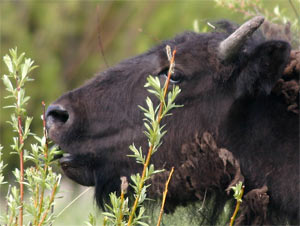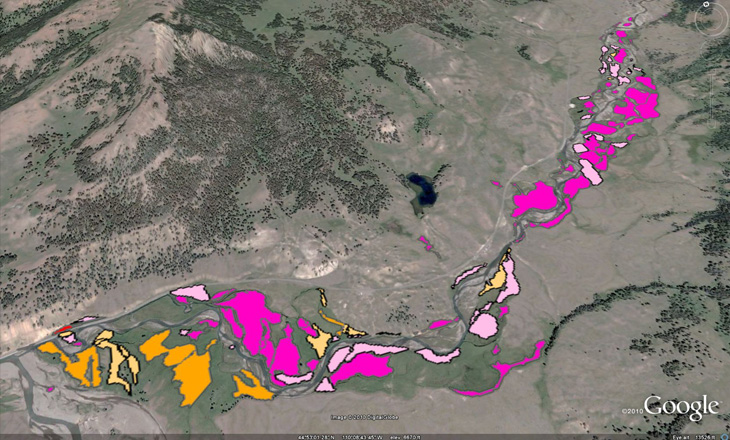
Landscape-level changes in riparian willow on Yellowstone's northern range
 |
Our work on Yellowstone willow has gone in two directions. From June 2005 - June 2007, we conducted an ecological study that sought to identify abiotic factors that influence the growth of stream-side (riparian) willow. The results of that study will appear in Western North American Naturalist (volume 70) during the last quarter of 2010. The abstract of that article appears at the bottom of this page.
With funding from the National Park Service, the USGS, and the Natural Resources Protection Program (NRPP), we also have conducted an extensive mapping and inventory of riparian willow on the northern range of Yellowstone. |
|
This inventory, which was completed in September 2010, is one of the largest plant surveys ever conducted in Yellowstone. Covering approximately 378km of streams, and more than 40,000 plants in 14 different species, this six year effort should serve as a baseline dataset for studies involving climate change, trophic cascades, and plant taxonomy. The image below, taken from a Google Earth view of Soda Butte Creek, illustrates the level of detail involved. We estimate that we walked 4000 - 5000 miles to complete this project, often on difficult terrain in remote areas.
You can download a short movie here that depicts what it would be like to fly over the Lamar Valley and see our willow data marked on the landscape. You can download a pdf copy of our final project report here. This document cotnains over 150 pages in maps and a brief summary of the patterns that we observed in the field. The final data set is available as either a Google Earth layer or as an ESRI shapefile. Contact us if you would like a copy. The abstract of our ecological work on willow appears below: |
|
Bottom-up Factors Influencing Riparian Willow Recovery in Yellowstone National Park. Michael T. Tercek1, Robert Stottlemyer2, and Roy Renkin3 1. Walking Shadow Ecology, PO Box 1085, Gardiner, Montana, 59030, Email: Tercek@YellowstoneEcology.com 2. US Geological Survey, Fort Collins, Colorado, 80526 3. Yellowstone Center for Resources, National Park Service, Yellowstone National Park, Wyoming 82190 Abstract After the elimination of wolves in the 1920s, woody riparian plant communities on the northern range of Yellowstone National Park (YNP) declined an estimated 50%. After the reintroduction of wolves in 1995-1996, riparian willows on YNP’s northern range were reported to show significant growth for the first time since the 1920s. The pace of willow recovery has not been uniform. Some communities have exceeded 400 cm while others are still at pre-1995 levels of less than 80 cm mean height. We intensively measured abiotic factors, including soil and water table characteristics, to determine whether these factors might be contributing to the varying pace of willow recovery. All of our study sites were "short" prior to 1995 and have recovered to varying degrees since. We contrasted "tall" willow sites that had escaped elk browsing with "short" willow sites (<250cm max. height) that could still be browsed. Unlike studies that manipulated willow height with fences and artificial dams, we examined sites that had grown natural differences in height since the reintroduction of wolves. Tall willow sites had greater water availability, more rapid net soil nitrogen mineralization, greater snow depth, lower soil respiration rates, and cooler summer soil temperatures than nearby short willow sites. Most of these differences were measured both in herbaceous areas adjacent to the willow patches and in the willow patches themselves. This suggests they were not effects of willow height recovery but were instead preexisting site differences that may have contributed to increased plant productivity. Our results agree with earlier studies in experimental plots which suggest that the varying pace of willow recovery has been influenced by abiotic limiting factors that interact with top-down reductions in willow browsing by elk. |

